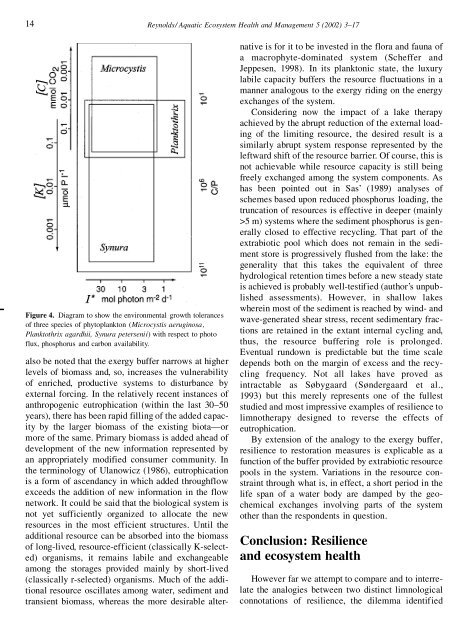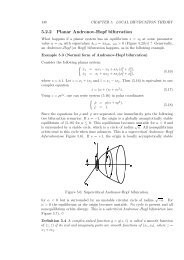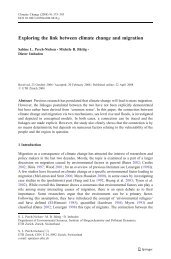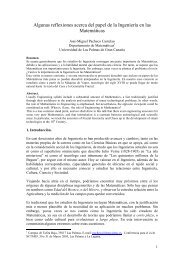Resilience in aquatic ecosystems - hysteresis, homeostasis, and ...
Resilience in aquatic ecosystems - hysteresis, homeostasis, and ...
Resilience in aquatic ecosystems - hysteresis, homeostasis, and ...
Create successful ePaper yourself
Turn your PDF publications into a flip-book with our unique Google optimized e-Paper software.
14<br />
Reynolds/ Aquatic Ecosystem Health <strong>and</strong> Management 5 (2002) 3–17<br />
Figure 4. Diagram to show the environmental growth tolerances<br />
of three species of phytoplankton (Microcystis aerug<strong>in</strong>osa,<br />
Planktothrix agardhii, Synura petersenii) with respect to photo<br />
flux, phosphorus <strong>and</strong> carbon availability.<br />
also be noted that the exergy buffer narrows at higher<br />
levels of biomass <strong>and</strong>, so, <strong>in</strong>creases the vulnerability<br />
of enriched, productive systems to disturbance by<br />
external forc<strong>in</strong>g. In the relatively recent <strong>in</strong>stances of<br />
anthropogenic eutrophication (with<strong>in</strong> the last 30–50<br />
years), there has been rapid fill<strong>in</strong>g of the added capacity<br />
by the larger biomass of the exist<strong>in</strong>g biota—or<br />
more of the same. Primary biomass is added ahead of<br />
development of the new <strong>in</strong>formation represented by<br />
an appropriately modified consumer community. In<br />
the term<strong>in</strong>ology of Ulanowicz (1986), eutrophication<br />
is a form of ascendancy <strong>in</strong> which added throughflow<br />
exceeds the addition of new <strong>in</strong>formation <strong>in</strong> the flow<br />
network. It could be said that the biological system is<br />
not yet sufficiently organized to allocate the new<br />
resources <strong>in</strong> the most efficient structures. Until the<br />
additional resource can be absorbed <strong>in</strong>to the biomass<br />
of long-lived, resource-efficient (classically K-selected)<br />
organisms, it rema<strong>in</strong>s labile <strong>and</strong> exchangeable<br />
among the storages provided ma<strong>in</strong>ly by short-lived<br />
(classically r-selected) organisms. Much of the additional<br />
resource oscillates among water, sediment <strong>and</strong><br />
transient biomass, whereas the more desirable alternative<br />
is for it to be <strong>in</strong>vested <strong>in</strong> the flora <strong>and</strong> fauna of<br />
a macrophyte-dom<strong>in</strong>ated system (Scheffer <strong>and</strong><br />
Jeppesen, 1998). In its planktonic state, the luxury<br />
labile capacity buffers the resource fluctuations <strong>in</strong> a<br />
manner analogous to the exergy rid<strong>in</strong>g on the energy<br />
exchanges of the system.<br />
Consider<strong>in</strong>g now the impact of a lake therapy<br />
achieved by the abrupt reduction of the external load<strong>in</strong>g<br />
of the limit<strong>in</strong>g resource, the desired result is a<br />
similarly abrupt system response represented by the<br />
leftward shift of the resource barrier. Of course, this is<br />
not achievable while resource capacity is still be<strong>in</strong>g<br />
freely exchanged among the system components. As<br />
has been po<strong>in</strong>ted out <strong>in</strong> Sas’ (1989) analyses of<br />
schemes based upon reduced phosphorus load<strong>in</strong>g, the<br />
truncation of resources is effective <strong>in</strong> deeper (ma<strong>in</strong>ly<br />
>5 m) systems where the sediment phosphorus is generally<br />
closed to effective recycl<strong>in</strong>g. That part of the<br />
extrabiotic pool which does not rema<strong>in</strong> <strong>in</strong> the sediment<br />
store is progressively flushed from the lake: the<br />
generality that this takes the equivalent of three<br />
hydrological retention times before a new steady state<br />
is achieved is probably well-testified (author’s unpublished<br />
assessments). However, <strong>in</strong> shallow lakes<br />
where<strong>in</strong> most of the sediment is reached by w<strong>in</strong>d- <strong>and</strong><br />
wave-generated shear stress, recent sedimentary fractions<br />
are reta<strong>in</strong>ed <strong>in</strong> the extant <strong>in</strong>ternal cycl<strong>in</strong>g <strong>and</strong>,<br />
thus, the resource buffer<strong>in</strong>g role is prolonged.<br />
Eventual rundown is predictable but the time scale<br />
depends both on the marg<strong>in</strong> of excess <strong>and</strong> the recycl<strong>in</strong>g<br />
frequency. Not all lakes have proved as<br />
<strong>in</strong>tractable as Søbygaard (Søndergaard et al.,<br />
1993) but this merely represents one of the fullest<br />
studied <strong>and</strong> most impressive examples of resilience to<br />
limnotherapy designed to reverse the effects of<br />
eutrophication.<br />
By extension of the analogy to the exergy buffer,<br />
resilience to restoration measures is explicable as a<br />
function of the buffer provided by extrabiotic resource<br />
pools <strong>in</strong> the system. Variations <strong>in</strong> the resource constra<strong>in</strong>t<br />
through what is, <strong>in</strong> effect, a short period <strong>in</strong> the<br />
life span of a water body are damped by the geochemical<br />
exchanges <strong>in</strong>volv<strong>in</strong>g parts of the system<br />
other than the respondents <strong>in</strong> question.<br />
Conclusion: <strong>Resilience</strong><br />
<strong>and</strong> ecosystem health<br />
However far we attempt to compare <strong>and</strong> to <strong>in</strong>terrelate<br />
the analogies between two dist<strong>in</strong>ct limnological<br />
connotations of resilience, the dilemma identified






